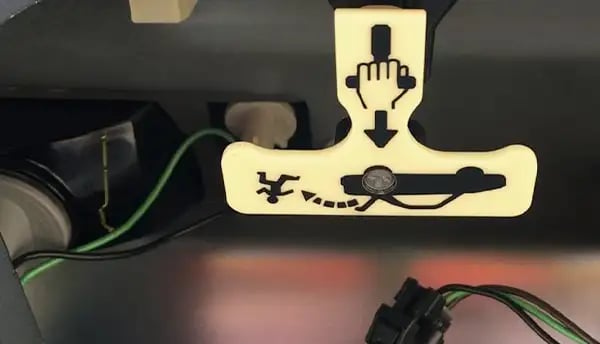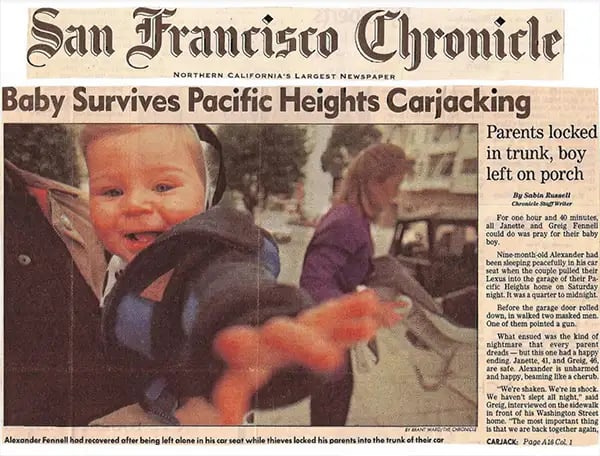Look in the trunk of your car and you’re likely to see a glow-in-the-dark emergency release lever.

This little T-shaped device has come stock in nearly every single one of the ~250m new cars sold in the US since 2002.
You’ve likely never used the lever — or even noticed it — but it took a monumental effort to get it there.

An emergency trunk release (Cars.com, via YouTube)
Like many safety devices in your car, the emergency trunk release was the result of one woman’s dogged fight against a multibillion-dollar industry intent on cutting costs.
Her journey required hundreds of hours of data collection, dozens of letters sent to auto execs, and years of persistence.
And it all began with a kidnapping.
‘I thought I was going to die’
Just before midnight on October 29, 1995, Janette Fennell and her husband pulled into their garage in San Francisco.
Fennell, then 41, was taking a break from a successful career as a marketing and sales executive to raise her first-born son, Alex. The couple had spent the evening at a friend’s house for dinner, and their 9-month-old was asleep in the backseat in a pumpkin-themed ensemble.
In an instant, their lives were upended.
As the Fennells exited their white Lexus, two armed intruders in Halloween masks forced them into the trunk of the family car.
The intruders removed Alex from the backseat and placed him, unharmed, inside the foyer.
Then — with Fennell and her husband locked in the trunk — they backed out the car and peeled out into the night.

Janette Fennell (far right) with her husband Greig and two sons several years after the incident (Courtesy of Ms. Fennell)
As the car sped down Highway 101, the couple scrambled to find a way out. Fennell clawed at the trunk’s carpeting, yanked on exposed wires, and slammed against the metal panel that was holding them in.
But the trunk wouldn’t budge.
“I remember thinking, ‘This is it — this is how it’s going to end,” Fennell recalled in a recent interview with The Hustle.
An hour later, the car came to a stop in a wooded area south of the city.
The assailants demanded everything the Fennells had on them: $5k in jewelry, $200 in cash, and debit card PIN numbers. Then, they slammed the trunk shut and fled.
The couple was alone. It was pitch black. And there was no way out.
Then, somehow — Fennell calls it “divine intervention” — they managed to ferret out a tiny piece of metal underneath the carpeting. “Greig reached over my body, found this little cable, and pulled it,” she recalls. “The trunk went bink and opened up.”
They found a payphone and frantically dialed 911. A short while later, their infant son was found safe at home.

A San Francisco Chronicle article from 1995 detailed Fennell’s ordeal (The San Francisco Chronicle; clippings courtesy of Ms. Fennell)
As time passed, life began to return to normal. But the kidnappers were never caught — and Fennell couldn’t rest easy knowing this could happen again to someone else.
“I went through the stages of grief,” she says. “But then I got to the point of being angry. I started to think, ‘This is ridiculous. Why is there no way to escape a car trunk?’”
No data, no problem
In the months following the kidnapping, Fennell decided to take action.
She wrote letters to every major car manufacturer inquiring why their trunks didn’t come with emergency release latches.
Nobody wrote back, she says.
Soon, she suspected that the auto industry abided by the axiom “no data, no problem.” If she wanted manufacturers to start installing emergency trunk releases, she’d have to prove that non-traffic vehicle accidents (like getting trapped in a trunk) were an issue at scale.
There was just one problem: No such dataset had ever been compiled.
The Department of Transportation’s National Highway Traffic Safety Administration (NHTSA) — the body that oversees vehicle-related accidents — maintained a database of fatal incidents called FARS, but it didn’t include cases where the car was stationary.
So, in late 1995, Fennell decided to collect her own data.
Using pre-Google search engines, the tenacious ex-exec sifted through thousands of old news articles and court transcripts.
“It was like taping together the paper in the shredding machine,” she says. “I’d put in ‘trunk’ and ‘locked in’ and get 10k matches. Then, I’d spend hours reading through every single result.”

Fennell, years later, posing with a safety mascot at a conference (courtesy of Ms. Fennell)
Through this tedious process, she was able to dig up 931 incidents involving 1,082 people getting locked in car trunks over the preceding 20 years. In one in four cases, the victim died — either from heat stroke, asphyxiation, or hypothermia.
These incidents fell into two major categories:
- Children who accidentally locked themselves in a trunk while playing.
- Kidnapping victims who’d been forced into a trunk by assailants.
Fennell also soon learned that she hadn’t been the first person to try to alert car manufacturers of this issue. She discovered more than two dozen petitions dating as far back as 1984 asking for the implementation of emergency trunk latches.
Through her research, she found documents in which automakers had run cost-benefit analyses and found that emergency trunk latches would cost between $0.20 and $4 per car to manufacture and install.
“It had been brushed off by the auto industry for years,” she says. “They just didn’t think it was worth the cost.” (Ford and GM did not respond to The Hustle’s requests to comment on this.)
Taking things to Washington
Fennell knew legislative history was on her side.
In the mid-1950s, after dozens of children died from getting locked in refrigerators, a bill had forced manufacturers to replace latches with magnetic doors.
In 1996, she launched her own association — the Trunk Releases Urgently Needed Coalition (TRUNC) — and expanded her reach.
Her first break came in 1997.
While visiting her mother in Wisconsin, she contacted a local police chief to ask some questions about a trunk death case in the state. The officer put her in touch with Bart Stupak, then a US Representative in Michigan.
Convinced by Fennell’s data, Stupak sponsored a bill to require a study on trunk entrapment and the NHTSA formed an expert panel to investigate.

Fennell sitting on a panel with Rep. Bart Stupak in the late ‘90s (courtesy of Ms. Fennell)
But before the panel convened, tragedy struck: During a 3-week heat wave in the summer of 1998, 11 children died after getting locked in car trunks.
Car manufacturers still weren’t convinced that emergency trunk releases were a necessity. They brought up two counter-arguments:
- Even if they added a trunk release, criminals could still disable it.
- Installing trunk releases would send a message to children that it’s OK to play in car trunks.
According to Atlas Obscura, there was some reticence at first among panel members.
But in late 1999, after hearing all the evidence, the NHTSA passed a mandate requiring every new car (2002 model or later) to come equipped with an emergency trunk release.
For Fennell, it was just the start
“After we got trunk releases mandated, I thought I was done — but that isn’t how it ended up going,” she says. “When you work on an issue like this, you never let go of it.”
People around the country started calling her with all other types of non-traffic car accidents — many affecting children.
So, Fennell launched Kids and Cars, a nonprofit dedicated to raising awareness of the dangers of vehicles as stationary machinery.

Fennell demonstrates a new trunk release in a Ford car at the NY International Auto Show in 1999 (photo va Getty Images)
Over the past 20 years, her organization has fought to pass legislation affecting a number of car safety features:
- Safer power window switches
- Mandatory brake-shift interlock systems that won’t let you take your car out of gear unless your foot is on the brake pedal.
- Seat belt reminders for backseat passengers
- Mandatory rear view cameras in all cars produced after 2018
As for the emergency trunk release?
Since it was mandated two decades ago, federal safety reports show that there hasn’t been a single documented trunk-related fatality in a car with one installed.
“If you look at any safety feature in your vehicle, just know there is somebody who fought and fought and fought to make sure that was there,” says Fennell.
That’s something that her son, Alex, is reminded of every day.
Just 8 months old on that fateful night in 1995, he’s now 26 and has an emergency release in his own car.
“Every time I open my trunk and see it,” he says, “I can say, ‘My mom made that happen.’”
